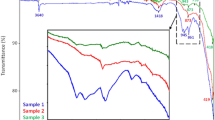Abstract
Radioactive substances released as nuclear power plant accident can contaminate soil in a wide area. Soil washing is used as decontamination technique for Cs-contaminated soil, which exhibits short processing time and maximization of Cs removal rate by applying flocculating agents. However, soil washing generates secondary waste in the form of sludge/slurry. In this context, proposed a method of pelletization and solidification of powdered waste to facilitate treatment/disposal of the Cs-contaminated fine soil (secondary waste). In addition, by characterizing the prepared waste form, it was examined whether waste form satisfies Waste Acceptance Criteria for disposal facilities in South Korea.








Similar content being viewed by others
References
Kim SI, Song JS (2018) A study on the evaluation of cesium removal performance in soil washing process using flocculating agent. J Radioannal Nucl Chem 316:1227–1232
Decommissioning after a nuclear accident: Approaches, techniques, practices and implementation considerations, IAEA Nuclear Energy Series, No. NW-T-2.10
Filipowicz B, Pruszynski M, Krajewski S, Bilewicz A (2014) Adsorption of 137Cs on titanate nanostructures. J Radioannal Nucl Chem 301:889–895
Mukai H, Motai S, Yaita T, Kogure T (2016) Identification of the actual cesium-adsorbing materials in the contaminated Fukushima soil. Appl Clay Sci 121–122:188–193
Park I, Lee JO, Do TG, Kim MJ, Go AR, Kim KP (2018) Calculation of dose conversion coefficients for radioactive cesium in contaminated soil by depth and density. J Radioannal Nucl Chem 316:1213–1219
Kozai N, Ohnuki T, Arisaka M, Watanabe M, Sakamoto F, Yamasaki S, Jiang M (2012) Chemical states of fallout radioactive Cs in the soils deposited at Fukushima Daiichi Nuclear Power Plant accident. J Nucl Sci Technol 49(5):473–478
Fukushi K, Sakai H, Itono T, Tamura A, Arai S (2014) Desorption of intrinsic cesium from smectite: inhibitive effects of clay particle organization on cesium desorption. Environ Sci Technol 48:10743–10749
Decommissioning and Remediation after a Nuclear Accident, International Experts Meeting 2013
Development of Waste Minimization, Clearance, and Environmental Assessment Technologies for Decommissioning of Aging Nuclear Power Plant, Report, NRF-2017M2B2B1072888
Korea Electric Power Corporation Research Institute of Technology, Development of radioactive waste solidification process program, KRC-87N-J05 (1989)
Lee HK, Jun BM, Kim SI, Song JS, Kim TJ, Park SB, Chang SE (2022) Simultaneous removal of suspended fine soil particles, strontium and cesium from soil washing effluent using inorganic flocculants. Environ Technol Innovation 27:102467
Bonin HW, Walker MW, Bui VT (2004) Application of polymers for the long-term storage and disposal of low- and intermediate-level radioactive waste. Nucl Technol 145(1):82–101
Ozdemir T, Usanmaz A (2009) Monte Carlo simulations of radioactive waste embedded into polymer. Radiat Phys Chem 78:800–805
Jung HS, Park YM, Nah CW, Lee JC, Kim KY, Lee CSY (2021) Evaluation of the mechanical properties of polyether sulfone-toughened epoxy resin for carbon fiber composites. Fibers Polym 22:184–195
Johanson JR (2010) A rolling theory for granular solids. J Appl Mech 32(4):1049–1057
Bindhumadhavan G, Seville JPK, Adams MJ, Greenwood RW, Fitzpatrick S (2005) Roll compaction of a pharmaceutical excipient: Experimental validation of rolling theory for granular solids. Chem Eng Sci 60:3891–3897
Lim SH, Kim SI, Song JS, Kim KH (2021) A study on the pelletizing condition for roll compaction of powdered radioactive wastes. Powder Technol 384:554–563
Yusof YA, Smith AC, Briscoe BJ (2005) Roll compaction of maize powder. Chem Eng Sci 60:3919–3931
Reimer HL, Kleinebudde P (2019) Hybrid modeling of roll compaction processes with the Styl’One Evolution. Powder Technol 341(1):66–74
Chou YS, Singh B, Chen YS, Yen SC (2022) Study on volume reduction of radioactive perlite thermal insulation waste by heat treatment with potassium carbonate. Nucl Eng Technol 54(1):220–225
Omar CS, Dhenge RM, Palzer S, Hounslow MJ, Salman AD (2016) Roller compaction: effect of relative humidity of lactose powder. Eur J Pharm Biopharm 106:26–37
Mangal H, Kirsolak M, Kleinebudde P (2016) Roll compaction/dry granulation: suitability of different binders. Int J Pharm 503:213–219
Korean Agency for Technology and Standards, ‘Standard test method for compressive strength of concrete, KS F 2405 (2010)
ASTM, 1979. Test Method for Thermal Cycling of Electroplated Plastics, ASTM B553
Nuclear Regulatory Commission, Technical Position on Waste Form, Rev.1, (1991)
American Nuclear Society, Measurement of the leachability of solidified low-level radioactive wastes by a short-term test procedure, ANSI/ANS-16.1 (2003)
Kalb PD, Heiser JH, Colombo P (1991) Long-term durability of polyethylene for encapsulation of low-level radioactive, hazardous, and mixed wastes. In: Proceedings of the American Chemical Society Symposium on Emerging Technologies for Hazardous Waste Management. 23(4).
Saleh HM (2014) Stability of cemented dried water hyacinth used for biosorption of radionuclides under various circumstances. J Nucl Mat 446:124–133
Acknowledgements
This work was supported by the National Research Foundation of Korea (NRF) and financially supported by a grant funded by the Korean government (MEST) (No. 2018M2B2B1065636). This study was supported by the Korea Institute of Energy Technology Evaluation and Planning (KETEP) and the Ministry of Trade, Industry & Energy (MOTIE) of the Republic of Korea (Grant No. 20214000000070).
Author information
Authors and Affiliations
Corresponding author
Additional information
Publisher's Note
Springer Nature remains neutral with regard to jurisdictional claims in published maps and institutional affiliations.
Rights and permissions
Springer Nature or its licensor (e.g. a society or other partner) holds exclusive rights to this article under a publishing agreement with the author(s) or other rightsholder(s); author self-archiving of the accepted manuscript version of this article is solely governed by the terms of such publishing agreement and applicable law.
About this article
Cite this article
An, JY., Yang, KT., Lee, MH. et al. A study on the pelletization and solidification of Cs-contaminated soil after soil washing. J Radioanal Nucl Chem 332, 2953–2962 (2023). https://doi.org/10.1007/s10967-023-08970-w
Received:
Accepted:
Published:
Issue Date:
DOI: https://doi.org/10.1007/s10967-023-08970-w




